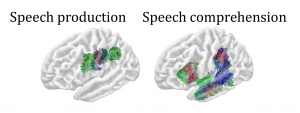This post is a summary of our recently published article, The Anatomy of Aphasia Revisited. This article appears in the March 2018 issue of the journal Brain. Link to full text here. In this study, we asked several questions that are very important to aphasia treatment research.
Can we predict a person’s strengths and weaknesses from types of brain damage? Speech-language pathologists (SLPs) give many tests to individuals with aphasia to determine their communication strengths and weaknesses.
In this study, we were interested in two main questions.
- First, how do models of speech processing inform clinicians about the difficulties an individual may experience after their stroke?
- Second, what patterns of brain damage predict these difficulties?
How is language organized in the brain? The model we focused on in this study is called the Dual Stream model of speech production. Research has shown that there are two “streams” responsible for different types of communicative information: dorsal regions and ventral regions (shown below).

Study methods: In this study, we looked at standard tests that are used to measure speech and language abilities. We related brain damage and connections between brain regions to performance on each test. Testing information and brain scans from 159 people were used in this study.
What do the results tell us about aphasia?We found that damage to dorsal regions was related to difficulty with speech production (for example, apraxia of speech and decreased fluency), and damage to the ventral areas was related to difficulty with comprehending speech.
The results also showed that some aspects of language, like repeating speech and naming items, use both dorsal and ventral streams, meaning damage to either stream can affect these behaviors.
We also found that white matter pathways (connections between parts of the brain) between different dorsal and ventral areas are important.
The picture below shows pathways that support production (left) and comprehension (right).

Why is this research important?
- Research suggests that using models (like the Dual Stream model) to understand aphasia and aphasia recovery leads to more effective treatments.
- This study shows that some areas are more specialized for different language functions, but importantly, that these regions must also work together, in harmony, to support language abilities.
- The results from this study are also important to speech-language pathologists and other clinicians who work with individuals with aphasia. In this article, we explain to clinicians, the types of brain damage that relate to performance on aphasia tests encountered in everyday clinical practice.